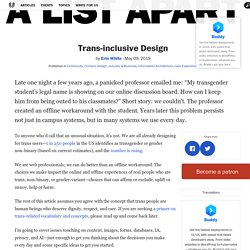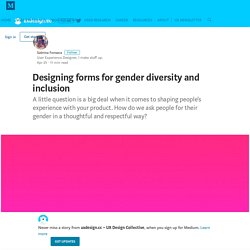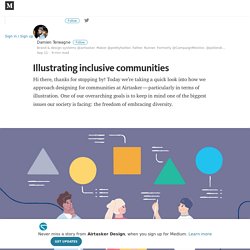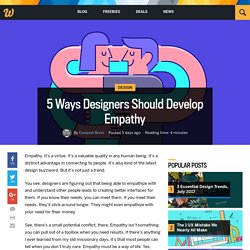

Trans-inclusive Design – A List Apart. Late one night a few years ago, a panicked professor emailed me: “My transgender student’s legal name is showing on our online discussion board.

How can I keep him from being outed to his classmates?” Short story: we couldn’t. The professor created an offline workaround with the student. Years later this problem persists not just in campus systems, but in many systems we use every day. Article Continues Below To anyone who’d call that an unusual situation, it’s not. We are web professionals; we can do better than an offline workaround. The rest of this article assumes you agree with the concept that trans people are human beings who deserve dignity, respect, and care.
I’m going to cover issues touching on content, images, forms, databases, IA, privacy, and AI—just enough to get you thinking about the decisions you make every day and some specific ideas to get you started. How we can get things right#section1 Names are fundamentally important#section2 Deadnaming#section3 Design for renaming. When we design for disability, we all benefit (vidéo, EN) L'heure est venue de refaire un point sur l'écriture inclusive. Temps de lecture: 6 min Je pensais tout savoir sur l’écriture inclusive, et puis j’ai lu le dernier livre d'Éliane Viennot et j’ai envie de m’excuser pour mon arrogance.

Il est temps de faire un «l’écriture inclusive, deuxième partie». Éliane Viennot a donc publié un très court ouvrage que je vous recommande chaudement, que vous vous intéressiez au féminisme ou à la langue française: Le langage inclusif: pourquoi, comment. C’est jouissif, stimulant, et cela vous permet de vous demander: quelles sont mes habitudes de langage, que véhiculent-elles et qu’est-ce que je souhaite y changer? Vous pouvez également écouter cette émission de France Culture, où Bernard Cerquiglini, linguiste et l'un de ceux qui ont participé aux premières batailles pour l’inclusif dans les années 1980, fait le point sur l’évolution de la langue –et c’est passionnant. Sus à la «féminisation» Sur cette idée de féminisation, Éliane Viennot explique également que l'on ne féminise pas des termes masculins.
Inclusivité LGBTQ* dans les formulaires (EN) Mul·ti·di·men·sion·al: of or involving several dimensions or aspects; exhibiting many diverse characteristics.

I started thinking about writing about gender diversity in design when I noticed how Facebook, Google+, OkCupid, Tinder and a few others have adapted their registration forms to be more inclusive of trans and gender non-conforming (GNC) people. Why isn’t everyone doing this, I thought? Asking for a person’s gender is a loaded question and there can be many answers to it.
Illustrer des communautés de façon inclusive (EN) If we want to ‘design for change’ we must first ‘change the way we design’.A little introspection can go a long way in making change happen.

Balancing data with beliefs Now for the tricky part. If you do a quick search, you can find a lot of articles touching on the subject. It’s a constant battle: should we design with data in mind or with our guts first and foremost? How do we balance both? On the one hand we have Job Posters (people creating the demand, posting jobs) – approximately 60% of them are female. On the other side, we have the Airtasker Workers (people meeting the demand, completing the tasks) – approximately 52% of them are male.
It’s one thing to design for our existing users, but we also want to stay open for all the potential ones out there. Doing this helps us knock out 2 birds with 1 stone: Diverse UI — Photos (portraits) Diversity and design. Diversity in Tech - Partie 1 : intro (EN) Diversity in Tech - Partie 2 : privilèges (EN) Diversity in Tech - Partie 3: profit/humanité (EN) Diversity in Tech - Partie 4 : égalité pour toutes (EN) Nurturing diversity at work and in your work. 5 façons de développer son empathie en design (EN) Empathy.

It’s a virtue. It’s a valuable quality in any human being. It’s a distinct advantage in connecting to people. It’s also kind of the latest design buzzword. But it’s not just a trend. You see, designers are figuring out that being able to empathize with and understand other people leads to creating better interfaces for them. See, there’s a small potential conflict, there. Empathy can help you make better designs, but it will…also enrich your life Empathy usually takes work, and requires development. 1.
Before we get to design-specific considerations, there are more general ways to develop empathy. Physical travel may not be necessary, but it helps Now, you may not have the budget to hit up China. 2. Find a cause you believe in (preferably one that involves helping humans), and dedicate some time to it. If you don’t have the resources to volunteer for any given cause, just look for time to socialize. 3. Lay aside your preconceptions, and truly listen 4. 5. Become the user. Consider the Image.